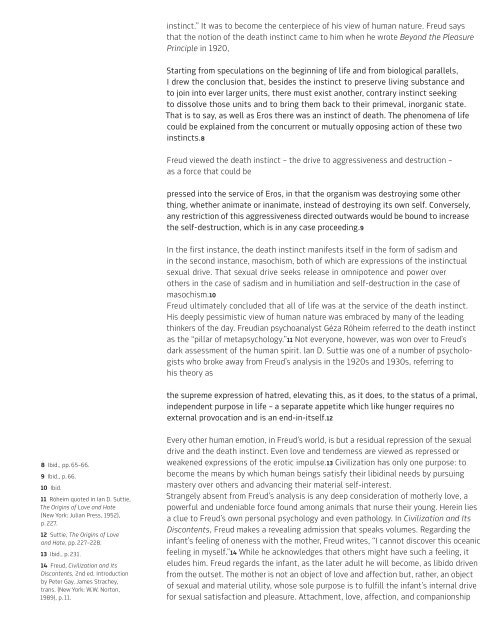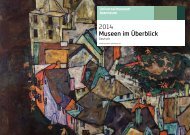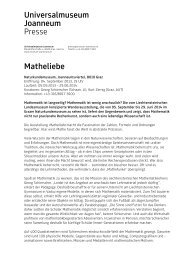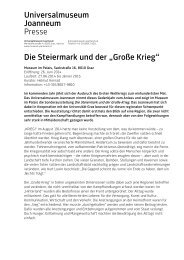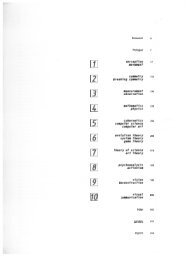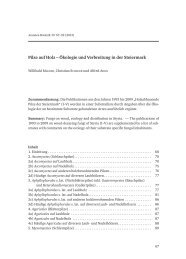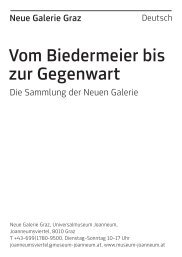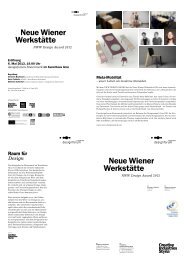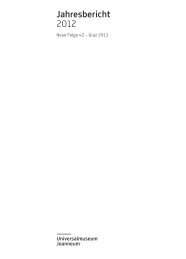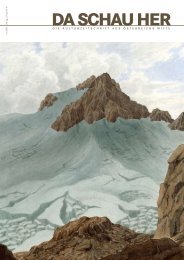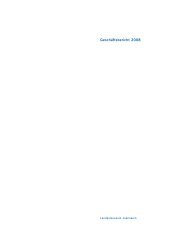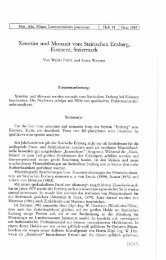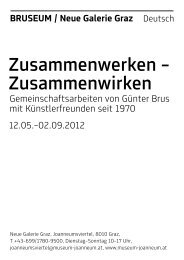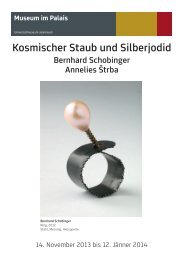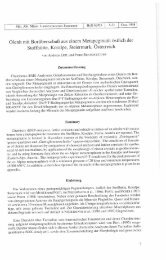Human Condition - Universalmuseum Joanneum
Human Condition - Universalmuseum Joanneum
Human Condition - Universalmuseum Joanneum
Erfolgreiche ePaper selbst erstellen
Machen Sie aus Ihren PDF Publikationen ein blätterbares Flipbook mit unserer einzigartigen Google optimierten e-Paper Software.
8 Ibid., pp. 65–66.<br />
9 Ibid., p. 66.<br />
10 Ibid.<br />
11 Róheim quoted in Ian D. Suttie,<br />
The Origins of Love and Hate<br />
(New York: Julian Press, 1952),<br />
p. 227.<br />
12 Suttie, The Origins of Love<br />
and Hate, pp. 227–228.<br />
13 Ibid., p. 231.<br />
14 Freud, Civilization and Its<br />
Discontents, 2nd ed. Introduction<br />
by Peter Gay. James Strachey,<br />
trans. (New York: W.W. Norton,<br />
1989), p. 11.<br />
instinct.” It was to become the centerpiece of his view of human nature. Freud says<br />
that the notion of the death instinct came to him when he wrote Beyond the Pleasure<br />
Principle in 1920,<br />
Starting from speculations on the beginning of life and from biological parallels,<br />
I drew the conclusion that, besides the instinct to preserve living substance and<br />
to join into ever larger units, there must exist another, contrary instinct seeking<br />
to dissolve those units and to bring them back to their primeval, inorganic state.<br />
That is to say, as well as Eros there was an instinct of death. The phenomena of life<br />
could be explained from the concurrent or mutually opposing action of these two<br />
instincts.8<br />
Freud viewed the death instinct – the drive to aggressiveness and destruction –<br />
as a force that could be<br />
pressed into the service of Eros, in that the organism was destroying some other<br />
thing, whether animate or inanimate, instead of destroying its own self. Conversely,<br />
any restriction of this aggressiveness directed outwards would be bound to increase<br />
the self-destruction, which is in any case proceeding.9<br />
In the first instance, the death instinct manifests itself in the form of sadism and<br />
in the second instance, masochism, both of which are expressions of the instinctual<br />
sexual drive. That sexual drive seeks release in omnipotence and power over<br />
others in the case of sadism and in humiliation and self-destruction in the case of<br />
masochism.10<br />
Freud ultimately concluded that all of life was at the service of the death instinct.<br />
His deeply pessimistic view of human nature was embraced by many of the leading<br />
thinkers of the day. Freudian psy choanalyst Géza Róheim referred to the death instinct<br />
as the “pillar of metapsychology.”11 Not everyone, however, was won over to Freud’s<br />
dark assessment of the human spirit. lan D. Suttie was one of a number of psychologists<br />
who broke away from Freud’s analysis in the 1920s and 1930s, referring to<br />
his theory as<br />
the supreme expression of hatred, elevating this, as it does, to the status of a primal,<br />
independent purpose in life – a separate appetite which like hunger requires no<br />
external provocation and is an end-in-itself.12<br />
Every other human emotion, in Freud’s world, is but a residual repression of the sexual<br />
drive and the death instinct. Even love and tenderness are viewed as repressed or<br />
weakened expressions of the erotic impulse.13 Civilization has only one purpose: to<br />
become the means by which human beings satisfy their libidinal needs by pursuing<br />
mastery over others and advancing their material self-interest.<br />
Strangely absent from Freud’s analysis is any deep consideration of motherly love, a<br />
powerful and undeniable force found among ani mals that nurse their young. Herein lies<br />
a clue to Freud’s own per sonal psychology and even pathology. In Civilization and Its<br />
Discontents, Freud makes a revealing admission that speaks volumes. Regarding the<br />
infant’s feeling of oneness with the mother, Freud writes, “I can not discover this oceanic<br />
feeling in myself.”14 While he acknowledges that others might have such a feeling, it<br />
eludes him. Freud regards the infant, as the later adult he will become, as libido driven<br />
from the outset. The mother is not an object of love and affection but, rather, an object<br />
of sexual and material utility, whose sole purpose is to ful fill the infant’s internal drive<br />
for sexual satisfaction and pleasure. Attachment, love, affection, and companionship


